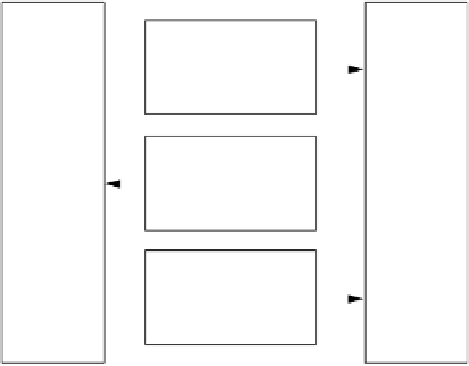Graphics Programs Reference
In-Depth Information
0 1 2 3
0 1 2 3 4 5 6 7 8 9 0 1 2 3 4 5 6 7 8 9 0 1 2 3 4 5 6 7 8 9 0 1
+-+-+-+-+-+-+-+-+-+-+-+-+-+-+-+-+-+-+-+-+-+-+-+-+-+-+-+-+-+-+-+-+
| Source Port | Destination Port |
+-+-+-+-+-+-+-+-+-+-+-+-+-+-+-+-+-+-+-+-+-+-+-+-+-+-+-+-+-+-+-+-+
| Sequence Number |
+-+-+-+-+-+-+-+-+-+-+-+-+-+-+-+-+-+-+-+-+-+-+-+-+-+-+-+-+-+-+-+-+
| Acknowledgment Number |
+-+-+-+-+-+-+-+-+-+-+-+-+-+-+-+-+-+-+-+-+-+-+-+-+-+-+-+-+-+-+-+-+
| Data | |U|A|P|R|S|F| |
| Offset| Reserved |R|C|S|S|Y|I| Window |
| | |G|K|H|T|N|N| |
+-+-+-+-+-+-+-+-+-+-+-+-+-+-+-+-+-+-+-+-+-+-+-+-+-+-+-+-+-+-+-+-+
| Checksum | Urgent Pointer |
+-+-+-+-+-+-+-+-+-+-+-+-+-+-+-+-+-+-+-+-+-+-+-+-+-+-+-+-+-+-+-+-+
| Options | Padding |
+-+-+-+-+-+-+-+-+-+-+-+-+-+-+-+-+-+-+-+-+-+-+-+-+-+-+-+-+-+-+-+-+
| data |
+-+-+-+-+-+-+-+-+-+-+-+-+-+-+-+-+-+-+-+-+-+-+-+-+-+-+-+-+-+-+-+-+
TCP Header Format
Note that one tick mark represents one bit position.
Figure 3.
The sequence number and acknowledgment number are used to maintain
state. The SYN and ACK flags are used together to open connections in a
three-step handshaking process. When a client wants to open a connection
with a server, a packet with the SYN flag on, but the ACK flag off, is sent to
the server. The server then responds with a packet that has both the SYN and
ACK flags turned on. To complete the connection, the client sends back a
packet with the SYN flag off but the ACK flag on. After that, every packet in
the connection will have the ACK flag turned on and the SYN flag turned off.
Only the first two packets of the connection have the SYN flag on, since those
packets are used to synchronize sequence numbers.
SYN packet
SYN on ACK off
seq # = 324808530
ack # = 0
SYN/ACK packet
SYN on ACK on
seq # = 288666267
ack # = 324808531
Client
Server
ACK packet
SYN off ACK on
seq # = 324808531
ack # = 288666268





